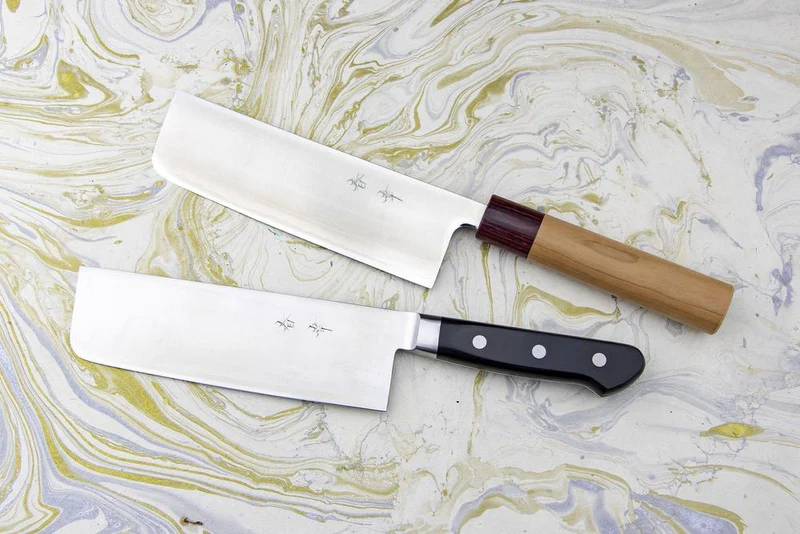To cook with precision and efficiency, you need the correct tools. Nakiri knives are popular among chefs and home cooks. The Nakiri knife is essential for chefs due to its distinctive form and utility.
This article will explain what a Nakiri knife is, its history, design, and why it is so popular for chopping and slicing vegetables.
What is a Nakiri Knife?
A Nakiri knife is a Japanese vegetable-cutting knife. It has a straight blade, flat profile, and square tip. “Nakiri” is Japanese for “vegetable slicer” or “leaf slicer,” describing its major use.
History of the Nakiri Knife
The Nakiri knife emerged in the Edo era, around the 18th century, from ancient Japan. Japanese cuisine flourished throughout this period.
As the vegetarian Buddhist community grew and relied more on vegetables, the need for a carefully built tool for vegetable preparation became obvious. Thus, Japan’s growing vegetarian population inspired the Nakiri knife.
Design Features of a Nakiri Knife

Nakiri knives are unique in design. Let’s examine its main design elements:
Blade
Nakiri knives have high-quality carbon or stainless steel blades. Thin and flat, it cuts precisely. The flat edge helps cut veggies precisely. The knife’s straight edge makes complete contact with the cutting board, preventing delicate veggies from bruising or ripping.
Shape
Nakiri knives have straight tips, unlike Western-style knives with curved blades. This design offers a smooth push cut motion to chop veggies easily. The squared-off tip helps with delicate cutting and trimming.
Weight, Balance
Lightweight nakiri knives are agile. Well-made Nakiri knives balance at the bolster or blade-handle junction. This balance optimises control and reduces fatigue during long use.
Handle
Nakiri knives have full-tang wooden handles made of walnut or ebony. This sturdy build allows for a pleasant grip and precise handling.
What is a Nakiri Knife Used For?

Nakiri knives are used for precise vegetable cutting. Its unusual shape and sharp blade make it ideal for vegetable preparation. Discussing Nakiri knife uses:
Slicing: Nakiri knives slice vegetables easily due to their flat edge and straight blade. The Nakiri knife makes consistent bell pepper slices and paper-thin cucumber slices.
Dicing and Chopping: The Nakiri knife is great for dicing and chopping vegetables due to its narrow blade and straight edge.
The Nakiri knife slices carrots, potatoes, kale, and spinach precisely and evenly. Its flat shape lets you slice ingredients evenly and professionally.
Julienne and mincing: The Nakiri knife’s sharp, straight blade is perfect for julienne and herb mincing. The Nakiri knife can neatly chop garlic, shallots, and fresh herbs like parsley and cilantro. It also cuts long, thin strips of carrots or zucchini for salads, stir-fries and garnishes.
Precision Work: The Nakiri knife’s squared-off tip and manoeuvrability make it ideal for precise work. The Nakiri knife can precisely remove bell pepper seeds and trim green bean ends. Its tiny blade minimises waste and protects vegetables.
Vegetable Sculpting: The Nakiri knife goes beyond vegetable preparation. Chefs use it for vegetable sculpting and ornamental cutting. The Nakiri knife makes complex garnishes and vegetable displays easy.
General culinary activities: The Nakiri knife is designed for vegetable preparation, but its versatility makes it useful for other culinary activities. The Nakiri knife’s sharpness and manoeuvrability make it useful for cutting fruits, boneless meats, and fish.
Nakiri Knife FAQs
Nakiri knives for meat and fish?
The Nakiri knife cuts vegetables, but its keen blade can also chop boneless meats and fish. It cannot cut bones or hard surfaces.
Nakiri knife sharpening: how?
Nakiri knives should be hand-washed and dried after use to keep them sharp. Honing and occasional whetstone sharpening will keep the blade sharp and in good shape
Left-handed Nakiri knives?
Yes, Nakiri knives are ambidextrous.Yes, Nakiri knives are ambidextrous.
A Nakiri knife on a glass or stone cutting board?
Glass and stone cutting boards can harm Nakiri knives. For knife safety, use wood or plastic cutting boards.
How do Nakiri and Santoku knives differ?
Nakiri and Santoku knives are multipurpose culinary equipment with different designs and uses. With its flat edge and squared-off tip, the Nakiri knife is meant for vegetable cutting, while the Santoku knife may slice, dice, and chop.
Conclusion
For precise vegetable preparation, the Nakiri knife is a versatile and essential culinary tool. The Nakiri knife helps chefs and home cooks make elegant, uniform, and visually pleasing vegetable meals.
A Nakiri knife is a great tool for professional chefs and home cooks alike. Buy a good Nakiri knife, learn precise cutting skills, and appreciate the artistry and efficiency it provides to vegetable preparation.
